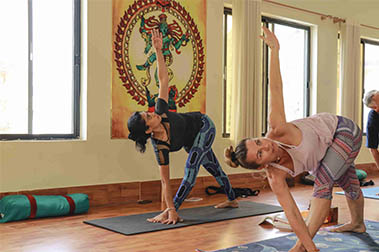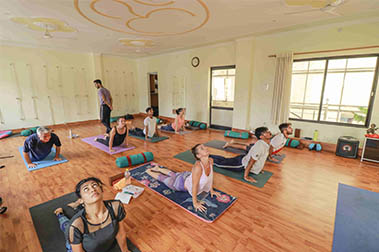200 Hour Hatha Yoga Teacher Training in Rishikesh
Our 200 hour Hatha yoga teacher training in Rishikesh is one of the most important programs that are offered by RYA. this training courses include the study of theories and practices of Hatha Yoga Asanas, Pranayama, Meditation, Kriyas, and Alignment and Adjustment Workshop by our highly experienced teachers. This course will prepare you with all the tools and confidence you need to become a yoga teacher and will inspire you forward on your personal yoga journey.
Rishikesh yoga association offers 200 Hour Hatha Yoga Teacher Training Courses in Rishikesh based on traditional hatha yoga. It is a residential hatha yoga course ideal forpractitioners of all levels who are looking to explore and deepen their practices, learn the art of teaching, and experience the ancient science of Hatha Yoga.
Hatha yoga is one of the most of the common form of yoga and as well base of all modern forms of yoga we have nowadays. But more commonly true concept of hatha is still unknown to many people.The word “hatha” is made of the roots ha, meaning “sun,” and tha, meaning “moon,” and that term was chosen to convey the idea that in our physical practices, we're striving to integrate the “solar” & “lunar” energies of the body.
These two major flow of energies known as “PINGLA” nadi and “IDA” nadi. By the practice of hatha yoga we focus on bring the balance of these two nadi because all physical and mental function happens through these nadis. Once we are able to balance the both flow (pingla and ida) third most important nadi which known as sushumnanadi get activated. Activation of sushumnanadi allows the kundalini (dormant energy) to rise up through the sushumnanadi.


200 Hour Hatha Yoga Teacher Training Course Syllabus
Mudras are some specific position of hand and body. Which are used to control or channelize the energy in the subtle body.
200 Hour Hatha Yoga Teacher Training Course Dates
| TIME | SCHEDULE |
|---|---|
| 6:30 - 7:30 Am | Pranayama |
| 7:45 - 9:15 Am | Hatha Yoga |
| 9:15 - 10:00 Am | Breakfast |
| 10:00 - 11:00 Am | Yoga Anatomy |
| 11:30 - 12:30 Pm | Yoga Philosophy |
| 1:00 - 2:00 pm | Lunch |
| 4:15 - 5:45 Pm | Ashtanga Vinyasa |
| 6:00 - 7:00 Pm | Meditation & Mantra Chanting |
| 7:15 - 8:00 Pm | Dinner |
| 10:00 Pm | Lights Off |
| START DATE | END DATE | STATUS | Fee |
|---|---|---|---|
| 1 Apr 2025 | 24 Apr 2025 | Available | |
| 1 May 2025 | 24 May 2025 | Available | |
| 1 June 2025 | 24 June 2025 | Available | |
| 1 July 2025 | 24 July 2025 | Available | |
| 1 Aug 2025 | 24 Aug 2025 | Available | |
| 1 Sep 2025 | 24 Sep 2025 | Available | |
| 1 Oct 2025 | 24 Oct 2025 | Available | |
| 1 Nov 2025 | 24 Nov 2025 | Available | |
| 1 Dec 2025 | 24 Dec 2025 | Available | |
| 1 Jan 2026 | 24 Jan 2026 | Available | |
| 1 Feb 2026 | 24 Feb 2026 | Available | |
| 1 Mar 2026 | 24 Mar 2026 | Available |
Inclusion / Exclusion in Course Fees
Note: All classes are mandatory for students.In case of an illnesses or emergencies student can take leave with due permission from the concerned teacher. Leaves without reasons won’t be accepted and this will severely effect the monthly performance of the student.